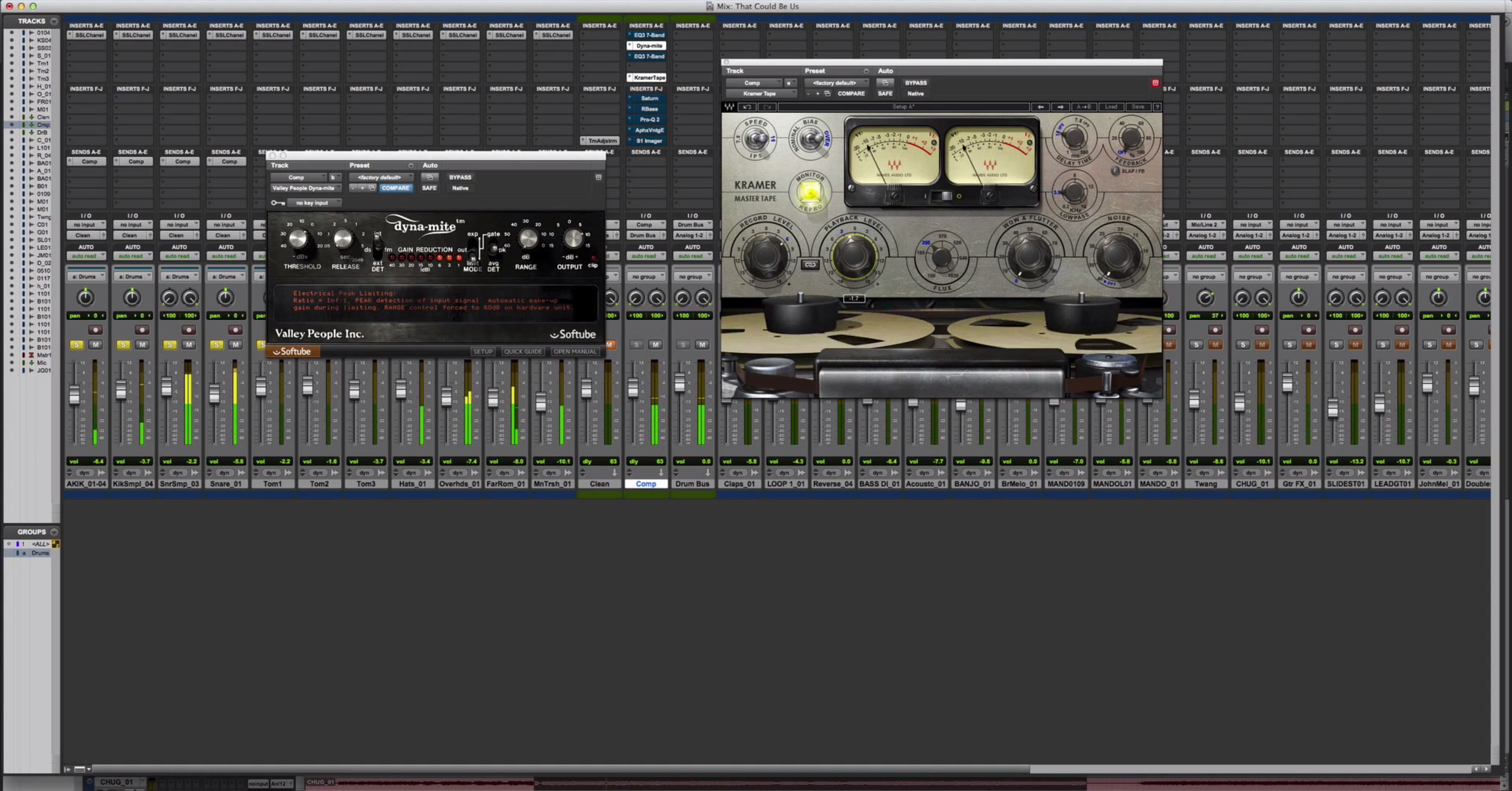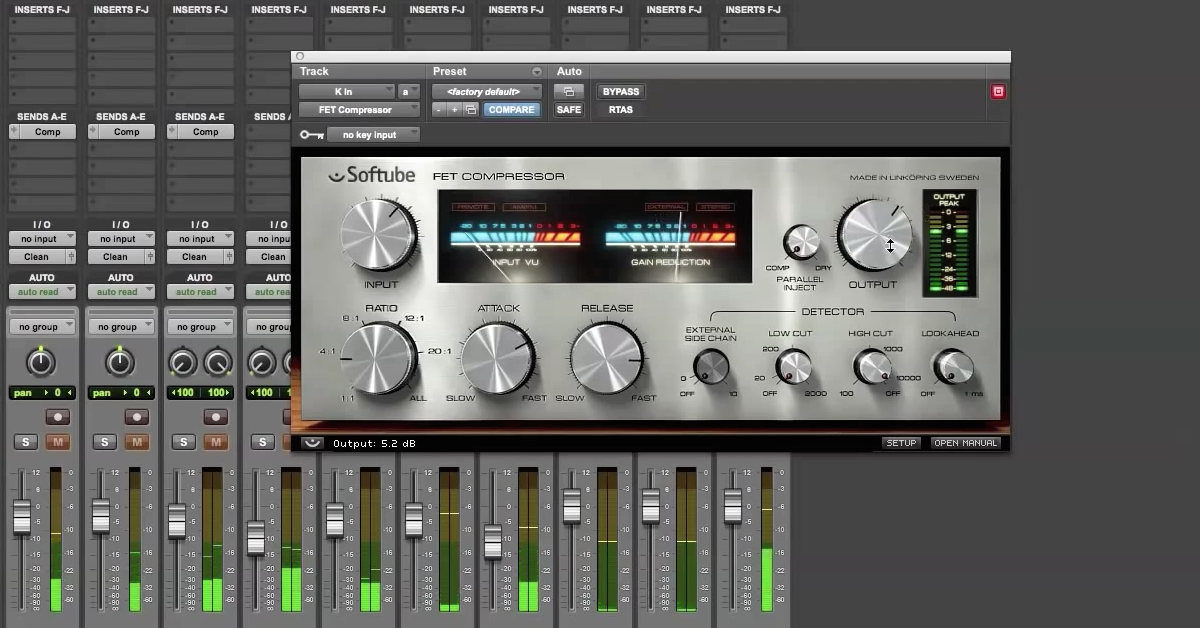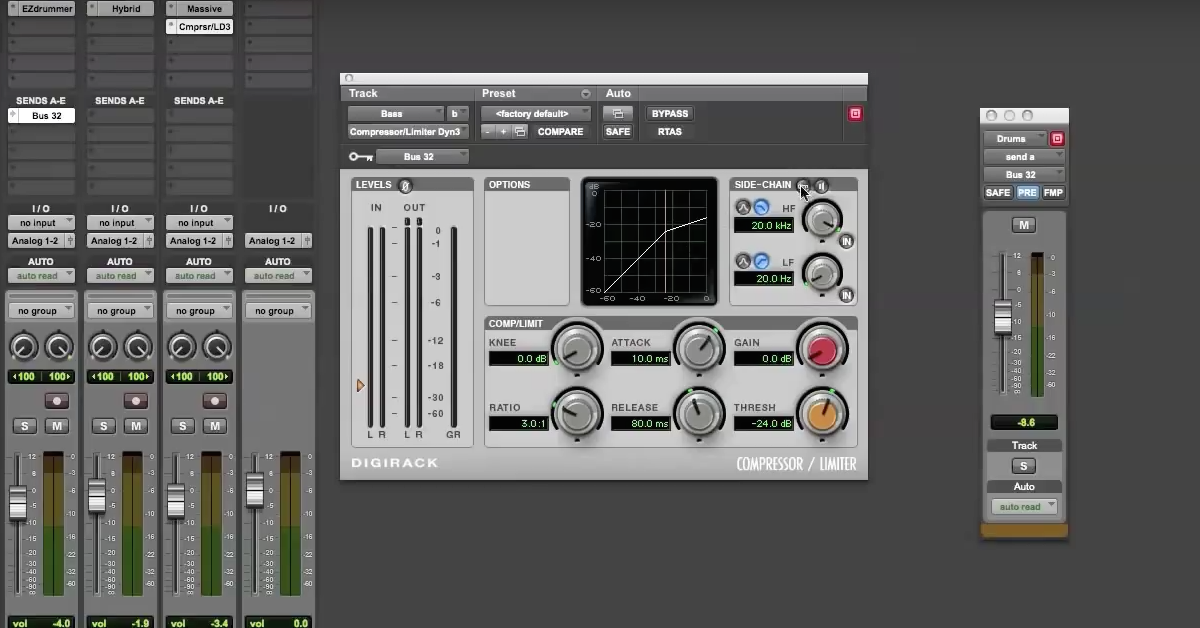How to Use Buss, Parallel and Sidechain Compression for Mixing Drums
I’ve inserted the stock Pro Tools compressor in the first plug-in slot. Right now it’s in bypass mode so I can play back the audio without any processing.
So right now the drum sounds pretty good but I know in the context of a full mix they’re not going to sound that great. They’re going to sound dull, lifeless and not really cut through. What I’m going for is that larger than life, very punchy, modern rock drum sound. This is where compressors come in.
Right now I’ve got this plug-in inserted in the typical way that you would use a compressor which is it’s just doing a little bit of processing on the signal that is getting passed through it. I’ve got your typical settings, conventional setting is six to one ratio, medium attack, medium release. I will just bring down the threshold a little bit until I’m achieving about minus six to minus twelve to be at gain reduction.
This is a little bit extreme but I’m using it as an example to maybe over-emphasize what’s going on.
I will have the makeup gain to compensate for the gain reduction. This why I can compare it to the how it sounded before.
By using the compressor in this manner, I know that what I’m achieving is that long sustained drum sound that’s bringing out the room mikes and I like that. That’s part of the sound that I’m going for.
There’s a couple of issues, though. First off, it sounds like my compressor is starting to pump a little bit, especially when the kick drum is being played. Also, I feel like the train [??] are kind of getting squashed a little bit too much and they’re not really cutting through and my drums aren’t really punchy because of that. So with this compressor setting, I’m achieving some of the things that I like but there’s some issues on things I need to address.
I’ll play it back now and let you focus on what I was describing.
First thing I’m going to address is the problem of the pumping. The way that I’m going to do that is to use side chain compression. The way that it works is that right now the signal that passes through the compressor is the one that the detector of the compressor is listening to. So when the signal passes through, the compressor has a threshold and if the signal level goes above that the compressor detects that the signal goes above the threshold, then it’s going to cause some gain reduction. However, with side chain compression, that detector that the compressor listens to is not focusing on the signal that is going to actually compress but is listening to a separate signal to decide when it’s going to apply gain reduction to the other signal.
For the stock Pro Tools compressor, there’s a side chain built into it that I’m going to be using. What I want to do is have the side chain filter out a lot of the low frequency energy in my drum mix. What that’s going to do is cut out the kick drum so that the compressor isn’t listening to a lot of signal that is being generated by the kick drum. It’s just listening to the, focusing more on other the instruments.
The way that you can just listen to that is click on the speaker right here. And you click on this one, is a high pass filter that I’m going to be using with it. It’s just going to cut the low frequencies out. So I’ll bring it in and then sweep it up so that you can hear what’s going on.
So the detector of the compressor is listening to this signal. You can see the gain reduction right now is only going on when the snare is hitting. It’s not going on when the compressor is going. If I turn this off, it’s starting to pump again.
So by using this side chain compressor, I am no longer having gain reduction during the kick drum. Now I’m monitoring the full mix again, a little bit too much make up gain. You can see the gain reduction is only when the snare is [??]. So I’ve accomplished the issue and solved the issue of the pumping. Next let me address the problem with the transients.
I want my transients to cut through but I also want a long sustained sound. The way to do this is to set up a parallel track. I’ve got one already set up a little bit. I’ve called it comp so I’m going to have my clean track here and my compression track here. I’ll copy this compressor over to here. Now I’ve got them running in parallel. If I switch this one, the insert on it to drum buss, now what’s going to happen is I’m going to use this track to really compress the signal and this one to run clean and have no compression on it. So I’ll go into this one, bring the threshold down so basically the compressor is not going to do anything to the signal. Go over here and look at the other one. This is where I can play around with my high pass filter to get a little bit of pumping, not too much, but have plenty of compression and really squash the signal. Then what I’ll do is just mix these two together. This way you can get some pretty extreme sounds but also maintain that clean polished sound as well. By mixing the two together that’s when you get punchy sounds that also have long sustained.
So let me mute this one to begin with and focus on my squash sound. Let’s hear the difference. Clean, compressor. So what I’ll do is just start out like this and mix it in. Together it’s punchy but it also has that nice sustain. I’ve also solved the problem of the pumping.
Now, right now I’ve just been using the stock Pro Tools compressor and when you’re using it it takes little bit of special routing. You have to use two auxiliary tracks if you want to do parallel compression. There are some plug-ins that come with parallel compression already built-in, then you don’t even need to do this other track. I’m going to make it active right now, go over here, I’m going to open up the Waves HComp.
There are similar settings on it, tack, release, threshold, ratio, all those things, but over here there’s a mix knob that goes from the dry to the wet and this is kind of what I was doing over here when I had the two tracks. This one was basically my dry track and this one was my wet one. I’m kind of just balancing them together but with this one you can go between dry and wet.
So I’ll play you back the audio, get compressor, settings how I like. Pretty extreme compression. And then just mix the dry in. It’s just a different way of doing parallel compression.
Last thing I want to demonstrate is how you can route the signals, specifically to your compressor so that if you have things like kick drum pumping that your compressor ignores it. So what I’m going to do is set this up as compressor and this is a different, rather than having the same signal from all these track go into here, I’m just using a separate input. So I’ll go over here to my things to bring up comp, set it on pre so it’s pre-fader and the fader doesn’t change it, so my kick drum I’m now going to bring the level down for that and for my snare bring the level up so that the snare is causing my compressor to get a lot of the signal, just a little bit on the overheads, not a lot on the room.
This is going to be really punchy now. So mute this. So you can hear there’s not a lot of kick drum going into my compressor. Now I’ll blend it in. This is where it starts to get really punchy if that’s what you’re going for.






